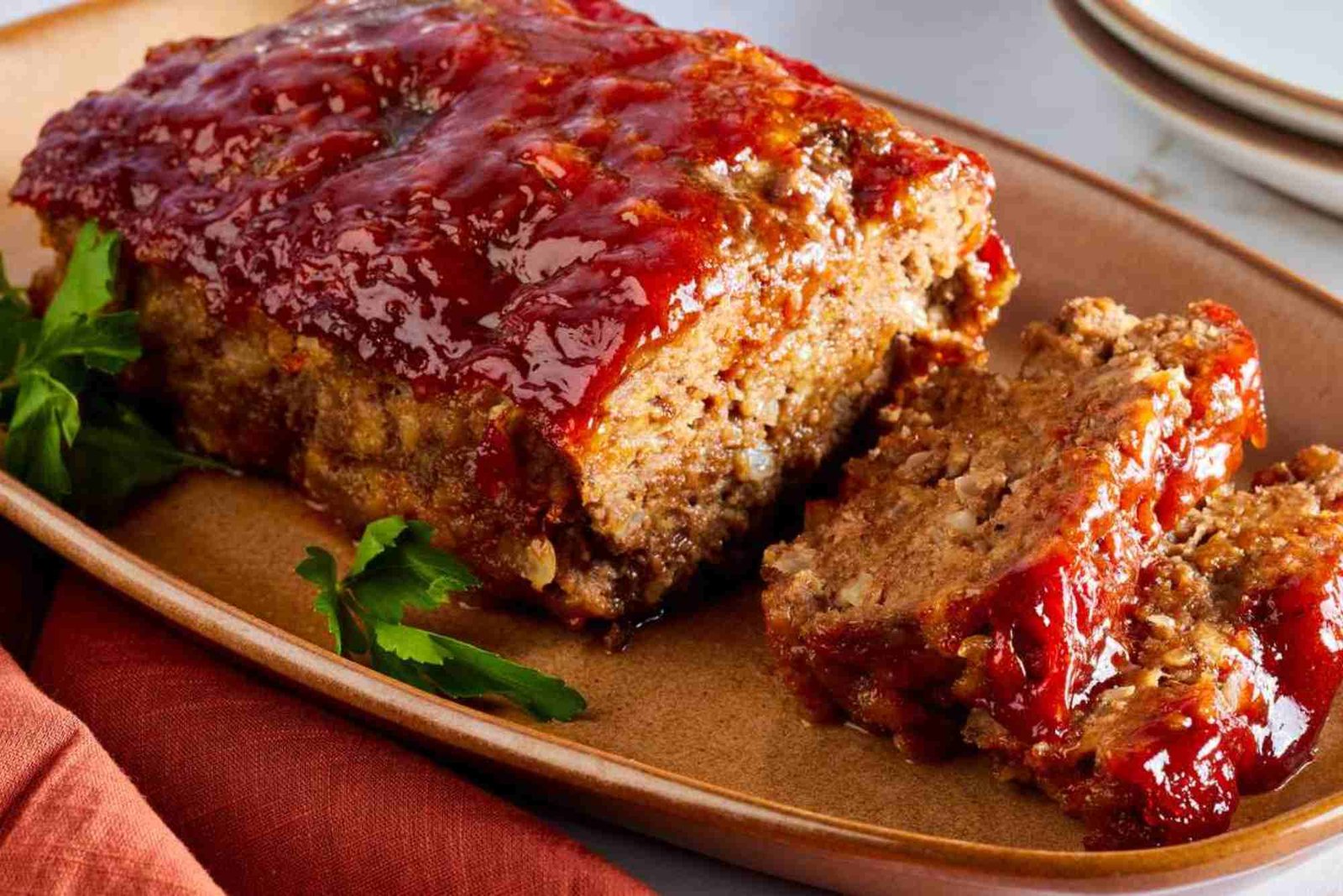Introduction
Nothing says comfort food quite like a perfectly baked meatloaf. The Ultimate Meatloaf Recipe Guide is more than just a set of instructions—it’s your roadmap to achieving a juicy, flavorful, and tender loaf every single time. Whether you’re cooking for a weeknight dinner or a family gathering, mastering this classic dish can turn a simple meal into a memorable one. In this guide, we’ll explore practical tips, techniques, and flavor combinations that elevate your meatloaf from ordinary to extraordinary.
Understanding the Basics of Meatloaf
Before diving into advanced techniques, it’s important to understand what makes a great meatloaf. Traditionally, meatloaf combines ground meat, breadcrumbs, eggs, milk, and seasonings. The goal is to achieve a moist texture that holds together well when sliced.
A balance of fat, moisture, and binding agents ensures your meatloaf doesn’t fall apart or turn dry. Using a mix of meats—such as beef and pork—creates the ideal texture and flavor depth.
Choosing the Right Meat
Ground beef is the foundation of most recipes, but not all beef is created equal. Opt for ground beef with around 80% lean and 20% fat content. This ratio adds the necessary richness and moisture without making your loaf greasy. Combining beef with ground pork or veal enhances flavor complexity and tenderness.
The Role of Binders
Eggs and breadcrumbs act as essential binders in any Ultimate Meatloaf Recipe Guide. They hold the ingredients together and prevent crumbling. Use fresh breadcrumbs soaked in milk for a softer, more cohesive texture. For a gluten-free version, substitute oats or crushed rice crackers.
Seasoning Matters
Never underestimate the importance of seasoning. Salt, pepper, onion, garlic, and herbs like parsley or thyme infuse every bite with flavor. Add Worcestershire sauce or mustard for depth, and a hint of tomato paste for sweetness and color.
Practical Tips for Perfect Meatloaf
Cooking a flawless meatloaf requires more than just mixing and baking. Every step—from shaping to glazing—impacts the final result.
Mix Gently
Overmixing the ingredients can lead to a dense, tough loaf. Use your hands to combine the mixture just until blended. Mixing too long breaks down the proteins and removes the air needed for tenderness.
Avoid the Loaf Pan Trap
While a loaf pan seems traditional, it traps grease, leading to soggy meatloaf. Instead, shape your loaf by hand and place it on a lined baking sheet. This allows heat to circulate evenly and excess fat to drain away.
Use a Flavorful Glaze
A sweet and tangy glaze not only adds shine but also complements the savory meat. A simple mix of ketchup, brown sugar, and vinegar works beautifully. Brush it on halfway through baking for a caramelized finish.
Monitor Internal Temperature
The ideal internal temperature for a fully cooked meatloaf is 160°F (71°C). Use a digital meat thermometer to ensure it’s perfectly done without drying out. Overcooking can quickly ruin your effort.
Let It Rest Before Slicing
Resting the meatloaf for 10 minutes allows the juices to redistribute, ensuring every slice stays moist. Cutting too soon can cause the juices to run out, leaving your loaf dry.
Creative Variations to Try
The classic recipe is just the beginning. Experimenting with ingredients and toppings can bring exciting new flavors to your table.
Italian-Style Meatloaf
Add Parmesan cheese, Italian herbs, and a layer of marinara sauce. Serve it with spaghetti for a hearty twist on a traditional favorite.
BBQ Meatloaf
Replace the ketchup glaze with smoky barbecue sauce. Combine onions, garlic, and chili powder in the mix for an irresistible Southern-inspired flavor.
Turkey or Chicken Meatloaf
For a lighter version, use lean ground turkey or chicken. Add sautéed vegetables and olive oil to maintain moisture and boost nutrition.
Stuffed Meatloaf
Create a surprise center by stuffing your loaf with cheese, spinach, or mushrooms. This adds a burst of flavor and visual appeal when sliced.
Common Mistakes to Avoid
Even experienced cooks make errors when preparing meatloaf. Avoiding these pitfalls can save your dish from disaster.
Using Lean Meat Only
Meatloaf made with lean meat alone can be dry and crumbly. Always include a portion of fatty meat to keep it juicy.
Skipping the Resting Time
Patience pays off. Letting your meatloaf rest is crucial for moisture retention and easy slicing.
Forgetting the Glaze
A glaze does more than look good—it locks in flavor. Even a simple ketchup topping can transform the final dish.
Pairing and Serving Suggestions
A well-prepared meatloaf deserves the right sides. Mashed potatoes, roasted vegetables, or buttered green beans are timeless companions. For a modern twist, serve it with a fresh salad or quinoa pilaf. A touch of gravy or mushroom sauce can elevate it further.
Pair it with a light red wine like Pinot Noir, or a sparkling water with lemon for a refreshing balance.
Storing and Reheating Tips
Meatloaf is one of those dishes that taste even better the next day. Store leftovers in an airtight container in the refrigerator for up to four days. Reheat slices in the oven at 325°F until warmed through. Avoid microwaving—it tends to dry the meat. For long-term storage, freeze cooked slices wrapped in foil for up to three months.
Healthier Substitutions
A few simple swaps can make your meatloaf healthier without sacrificing flavor. Use ground turkey or chicken for reduced fat content. Replace breadcrumbs with oats for added fiber. Instead of sugar-laden ketchup, try homemade tomato purée sweetened with honey or maple syrup.
Adding vegetables like grated zucchini, carrots, or spinach increases moisture and nutrients. These simple adjustments can make your recipe both delicious and nutritious.
If you love exploring nutritious food options, check out this Related Food article. It offers insights on maintaining motivation and making better lifestyle choices—perfect for those balancing indulgence and health.
You can also explore more culinary inspiration at The Ultimate Meatloaf Recipe Guide, featuring diverse food topics and cooking techniques that bring creativity to your kitchen.
For a deeper understanding of ingredients and cooking methods, visit More details for background information on food science and preparation.
FAQs
How do I keep my meatloaf from falling apart?
Ensure you have enough binders—use eggs and soaked breadcrumbs to hold everything together. Avoid overmixing, which can make the loaf too dense.
Why does my meatloaf turn out dry?
Dry meatloaf usually means it’s overcooked or made with lean meat only. Use ground beef with 20% fat and don’t skip the resting time.
Can I make meatloaf ahead of time?
Yes, prepare the mixture and refrigerate it for up to 24 hours before baking. This helps flavors meld and saves time on busy days.
Should meatloaf be covered while baking?
Cover it for the first half of baking to retain moisture. Uncover during the last 15 minutes to let the glaze caramelize beautifully.
What’s the best side dish for meatloaf?
Mashed potatoes, green beans, or roasted carrots pair perfectly. For a lighter option, try a crisp green salad or cauliflower mash.
Mastering meatloaf isn’t about luck—it’s about understanding texture, flavor, and technique. With these practical tips, you can confidently prepare a meatloaf that’s moist, flavorful, and crowd-pleasing. The Ultimate Meatloaf Recipe Guide empowers you to customize your dish, experiment with ingredients, and achieve consistent results every time.








